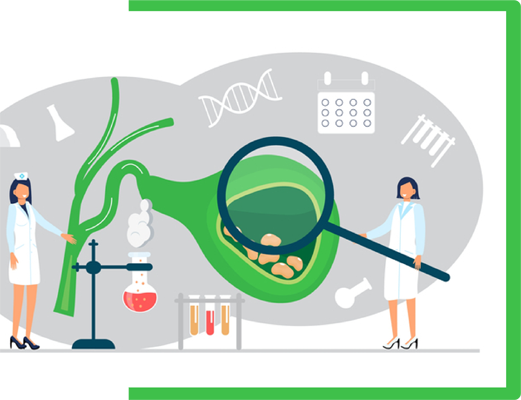

Our gallbladder lies below our liver, above the right belly. It is a hollow, pear-shaped organ. Our gallbladder is part of the human biliary system. It becomes a muscular pocket or scan in mature humans. The volume of this organ is around 50 ml. Our gallbladder is a sensitive organ and prone to several diseases. It is prone to gallbladder attacks, gallbladder illnesses as well as gallstones. Gallbladder cancer initiates from the gallbladder, the only organ to store bile. More than 200 cancer categories have been identified based on origin. These are called primary cancers. When this cancer spreads across other body parts, it is called metastasis.
The oncology department at Medica provides globally recognized cancer treatment facilities. The department is supported with clinical experience spanning more than three decades. Medica also boasts the latest technology for gallbladder cancer treatment. Our approach is multidisciplinary, and we focus on treating all forms and types of cancers. Our Onco-surgeons get support from skilled and experienced reconstructive surgeons. We deliver comprehensive Gallbladder Cancer treatment plans for all patients, children, and adults alike.

Our gallbladder comprises several different cell types. As such, varied categories of gallbladder tumors have been identified. According to experts, any of the below cancerous cells can transform into gallbladder cancer.
Adenocarcinoma: It is the most widespread and common gallbladder cancer. They account for almost 85% of total gallbladder cancers. It starts in the cells that form the outer lining of the gallbladder. The gland cells produce mucus which is a thick fluid.
Adenosquamous Cancer: It is a gallbladder cancer with glandular cancer as well as squamous cancer. Doctors consider this as a case of mixed histology. The treatment is similar to other cancers.
Squamous Cell: These are skin-line cells found in the lining of the gallbladder and the gland cells. Treatment is similar to other cancer types. It is a relatively rare cancer type. This cancer type comprises around 5 percent of the total gallbladder cancers found.
Small-Cell Carcinoma: These are also called oat cell cancers. The cancers are oat-sized, hence the name.
Sarcoma: It is a cancer type affecting the protective or supportive tissues of our bodies. These are called connective tissues. These include blood vessels, nerves, and muscles. This tumor starts from the gallbladder’s muscle layer.
Endocrine Tumors: These are rare malignancies. They develop from the hormone-producing cells found in our digestive system. These are also called neuroendocrine tumors. A prevalent example of this gallbladder tumor is carcinoid tumors.
Lymphoma: This type of gallbladder cancer is rare and uncommon. The treatment is also different from other cancer types. For instance, surgery for lymphoma is improbable. Preferred treatment options for lymphoma are radiotherapy or chemotherapy.
Gallbladder diseases are often discovered with diagnosing for other symptoms like liver diseases. Gallbladder cancer symptoms are rare during the early stages. Symptoms are only found at later or advanced stages of the cancer. Some common symptoms for gallbladder tumor are:
Less common symptoms include:

DNA mutations result in gallbladder cancer. These mutations change the cells of the gallbladder and turn them cancerous. The mutated cells divide abnormally and become tumorous. Excess cells result in tumor that spread across the body. The real etiology associated with cancer varies from one individual to other. There are various reasons that can increase the risk of gallbladder cancer. Some of these risk factors are:
Age: Gallbladder cancer is more prominent among older adults. These include people above 70 years. It is less common among individuals below 50 years of age.
Gender: Women are more prone to developing gallbladder cancer. Out of 10 gallbladder patients, seven are women.
Family History: If your family member or ancestors had gallstones, the chances of you having gallbladder cancer increases. The genetic mutation known to increase the risk is called BRCA2. It can be genetically transferred.
Porcelain Gallbladder: Sometimes calcium deposits on the inner wall of the gallbladder. This is due to a condition called cholecystitis. In rare cases, this progresses into gallbladder cancer.
Cholecystitis: Cholecystitis is the inflammation of the gallbladder. It can also result in gallstones. It often gives rise to gallbladder cancer. Around 80 percent of gallbladder cancer patients have gallstones. It develops when bile minerals and cholesterol accumulate in our gallbladder.
Diabetes: Diabetic people including those with high levels of blood sugar are more prone to gallbladder cancer.
Obesity: Being overweight or obese results in significant hormonal changes. These result in cholecystitis and then gallbladder cancer. A diet lacking fiber and rich in carbs also increases gallbladder cancer risk.
Gallbladder Polyps: Polyps are non-cancerous or benign growth. They grow inside the gallbladder and turn into malignant tumors in time.
Smoking: Smoking enhances the risk of developing gallbladder cancer. Those working in metal and rubber factories are often exposed to toxic substances. One such toxic substance is nitrosamine which induces DNA changes. This increases the risk of developing cancer.
Pancreatic & Bile Duct Defects: Patients with defective or abnormal bile ducts are more prone to this cancer. These patients have defective connections between the pancreas and their bile duct. Sometimes there are outgrowths in the bile ducts. These malfunctions are often by birth. Yet, they are visible only in later stages and increase the risk of cancer.
Salmonella Infection: If a person has gallstones, the risk of developing salmonella infection increases. This further results in gallbladder cancer.
Experts have categorised gallbladder cancer into four different stages, starting from stage I to stage IV. Some doctors also refer a stage 0.
Stage 0: This is the earliest stage of gallbladder cancer. Here cancer cells are found only on the tissue lining of the gallbladder. Since the tumor is limited only to the lining area, some doctors might not consider it to be cancer at all. This is because the risk of cancer spreading is extremely low. Even early detection at this stage is rare and exceptional. Symptoms are also rare at this stage. Doctors often discover gallbladder cancer at this stage while removing gallstones.
Stage I: In this stage, invasive gallbladder cancer is diagnosed. In this stage, the cancer is limited to the inner tissue layers of the gallbladder. It is yet to spread across the surrounding tissues, organs, and lymph nodes.
Stage II: In this stage, cancer has reached the muscle layer of the gallbladder wall and also the adjacent connective tissues. It is yet to spread outside the gallbladder.
Stage III: Stage III can be further subcategorized into two parts.
Stage III-A: Cancer develops out of the wall of the gallbladder. It is yet to migrate to the adjacent lymph nodes.
Stage III-B: Cancer has reached the adjacent lymph nodes. It has also reached the gallbladder’s outer layer.
Stage IV: This is the most advanced stage of gallbladder cancer. The progression of cancer in this stage is significant. Stage four is further categorized into the following sub-stages.
Stage IV-A: In this stage, cancer reaches the blood arteries of the liver. It can also reach different organs in the body. Cancer can also spread across the nearby lymph nodes.
Stage IV-B: In this stage, cancer can be of any size and has reached the lymph nodes of other organs. It can also move to distant body organs in this stage.
Gallbladder cancer is often identified during the diagnosis of gallbladder inflammation or gallstones. It can also be discovered during surgeries. However, the majority of the cases remain hidden until symptoms are visible. After this, certain tests and exams are conducted to detect cancer and its prognosis.
Physical Examination: These include examining for discomfort, lumps or build-up of fluid within the abdomen. The doctor will examine the skin and eyes in case of jaundice symptoms.
Medical History: Examining the medical history is important to understand the symptoms and risk factors. These help in identifying malignancies.
Liver Function: Lab tests can determine live function such as levels of albumin, bilirubin. It can detect liver enzymes like alkaline phosphatase, GGT, ALT, and AST. Liver functions can help in diagnosing gallbladder cancer along with bile duct or liver diseases.
Imaging Tests: These include tests like MRI, ultrasonography, CT scan. These tests determine the tumor’s nature.
Tumor Markers: This test utilizes blood samples for testing biomarkers. These markers can develop as a manifestation of certain cancer types.
Biopsy: In the case of gallbladder cancer, a biopsy is rarely a preferred method. In gallbladder cancer, the malignancy usually spreads to other locations. As such, a surgical biopsy is the preferred option as it focuses on examining the cells gathered during the surgery.
Angiography: It is done via an angiogram which is a type of x-ray. This test is used to examine the blood arteries of the patient. The process involves introducing a minute plastic tube within the artery. This tube is injected with a contrast dye. The tumor is revealed via obstruction inside blood vessels from the dye.
Laparoscopy: This process involves using a laparoscope. It is a small tube comprising of video camera and light. It is introduced in the stomach of the patient through a microscopic incision. This tube examines the liver, gallbladder as well as adjacent organs. It can also perform a biopsy if needed. It is used to understand the extent and stage of cancer.
Cholangiography: It is a type of imaging test. It identifies if there is any clogging or construction within our bile ducts. It can also identify if the ducts are dilated. The method helps in planning surgery for gallbladder cancer. It can be conducted using magnetic resonance or it can be endoscopic.
Surgery: Two major surgical options are available for treating gallbladder tumor. These are palliative surgery and curative surgery. If cancer has metastasized then palliative surgery is used. This is because surgery might not be enough to eliminate the tumor entirely. Curative surgery is performed for removable cancers. These are cancers entirely removable during surgical procedures.
Chemotherapy: These are chemicals that are put inside the body. They enter the circulatory system and destroy the tumor cells. Chemotherapy is effective and as such, it is given with other treatment facilities. This helps achieve significant outcomes. When administered alone, it is to minimize cancer recurrence.
Radiation Therapy: Radiation therapy is generally preferred when treating gallbladder cancer. This is to minimize the risk of damaging the healthy tissues and cells.
Happy Clients
Recovery
Expert Doctors
Award